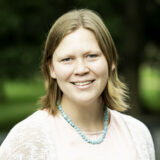Christa Kelleher ’08

Degrees
- Ph.D., Pennsylvania State University (2013)
- M.S., Pennsylvania State University (2009)
- B.S., Lafayette College (2008)
My Love for Teaching
At Lafayette, I teach courses in Water Resources Engineering and Land Development and Surveying. Learning and teaching about water science is my passion, and I get to share that excitement with my students through my course Water Resources Engineering. Between our hydraulics laboratory, local community sites, and Bushkill Creek (a five-minute walk from campus), students can see and measure many of the principles we discuss in class in the real world.
My favorite Lafayette course to teach is Land Development and Surveying. In this course, students learn how to survey the landscape as well as the factors that shape how we develop land. This is a course that relies heavily on teamwork and communication, which I think are crucial skills that all engineers should develop. What makes this course so much fun to teach is that it is ready-made for hands-on learning experiences and competitions. In the first half of the course, students compete week-to-week to achieve the lowest error in many of the exercises we pursue in the laboratory period. While the course emphasizes surveying methods for a portion of the semester, it’s set in the context of land development—essentially, how we as humans change the landscape through the development process.
As land development is a highly integrated field, it allows us as a class to touch on topics of land use zoning, preservation of green spaces, sustainability, stormwater, healthy communities, and many more topics that lead students to consider whether our built landscapes are as good as they could be, or whether we, as civil engineers (and as humans), could be doing more.
My Research Interests
I’m a hydrologist, which means I study how water moves at and below Earth’s surface, and how this in turn impacts water quality in our lakes and rivers. In particular, I study urban hydrology, which relates to how we as humans modify the water cycle through development, the introduction of impervious surfaces, and the replumbing of our subsurface by removing or adding soils and by adding below-ground infrastructure, like sewer pipes. I pursue research questions both locally in the Lehigh Valley as well as using publicly available data across the U.S. (and around the world).
What intrigues me most about hydrology is the search for patterns in the natural and not-so-natural environment. The first study I ever published was focused on understanding patterns of stream temperature across the state of Pennsylvania, and is work I’m hoping to keep pursuing here at Lafayette. We have lots of examples around the world that show that the way something looks influences its function; this is the same lens through which I pursue my work with hydrology, relating the way a watershed ‘looks’ (how developed it is, what climate it’s in, what its soils are like) to how it behaves, in terms of streamflow (the total amount of water in the stream, through time) and water quality (e.g., how warm the water is in the stream). I love doing research—it’s my way to make sense of the world around me.
Why Lafayette?
I first came to Lafayette many years ago as a student. I grew up in Oregon, but wanted to find a college where I could nurture my love of writing, play ultimate Frisbee, and pursue a degree in engineering. I found Lafayette and spent four great years here before eventually moving on to graduate school. Recently, the opportunity presented itself for me to return to Lafayette as a faculty member, and I jumped at the chance.
Returning to Lafayette as a professor means that I can create the same unique learning experiences for new generations of students that set me on my personal and professional path. Lafayette students are engaged and enthusiastic—they want to learn! It’s a joy to teach students at Lafayette.
My Personal Interests/Community Work
A lot of my community-based work focuses on K-12 education, as I grew up with an elementary school teacher for a parent. I’ve participated in the Connected Classroom initiative, where students from my courses created hands-on educational opportunities for students in a local second grade classroom. I am also advising a group of students who, partnering with local civil engineering professionals, are teaching high schoolers about the engineering, architecture, and construction fields.